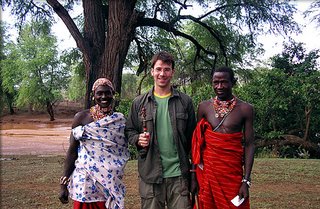Samburu District on NationalGeographic.com
I know my trip is over, but I still want to keep learning about the Samburu District, its people, and ways to help preserve this wonderful place. As part of that, I checked to see if there was anything about Samburu on National Geographic.com. There is! There are a few different articles on different parts of the site, but the one that has interested me most so far is called "Scenes from a Kenya Safari." It was originally from National Geographic Traveler. The author appears to have spent a large part of his visit to Kenya in the Samburu National Reserve, one of the two parks I visited. There are some great stories (I love the one about a lioness that adopted not one, but two, Beisa oryx calves and tried to protect them from other predators!) and some wonderful pictures of the animals and the Samburu people.
The author ends his article with this quote: "A safari teaches you to see, and seeing helps you understand. The patterns of a day may be simple, but the qualities of it are anything but. My guess is that every safarigoer makes two promises at the end of a journey: The first is never to forget the romance of the wild, and the second is to return again soon. These promises are why, though you may leave Africa, Africa will never leave you. It's a very specific relationship that way, one endlessly rich in its specificity." Although my expedition was not a tradtional safari, I can understand what he means. It is an amazing thing to really look and search the land as you drive through, to try to pick out the animals in the camouflaging bush. I learned that even very large animals can be hard to see when they want to hide. I learned the differences among different species, and trained myself to look for those little characteristics that would help make identification possible. On our first day, I strained to see a dikdik lying on the ground and thought that I would never be able to spot them without help from Sam and Nduhiu; after a few days of really watching, I found that the dikdiks had become a nuisance, so easy to see that I groaned at spotting them because it was "just another dikdik." But learning to quietly watch and appreciate the animals of Samburu really does teach you a lot about the world in which they live, even when you only see the tracks they leave behind. And the experience most definitely encourages you to return as soon as possible! Just as Madagascar is forever a part of who I am today, Kenya will be as well.
I recommend checking out the article when you have a chance! In the meantime, I'm going to see if I can try to track down the author through the magazine to share my impressions and experiences in Samburu with him.

The article's author, George W. Stone, with 2 Samburu guides who worked at the campsite where he stayed. (Photo by author, located at http://www.nationalgeographic.com/traveler/photos/africa0509/africa_gallery2.html.)





0 Comments:
Post a Comment
<< Home